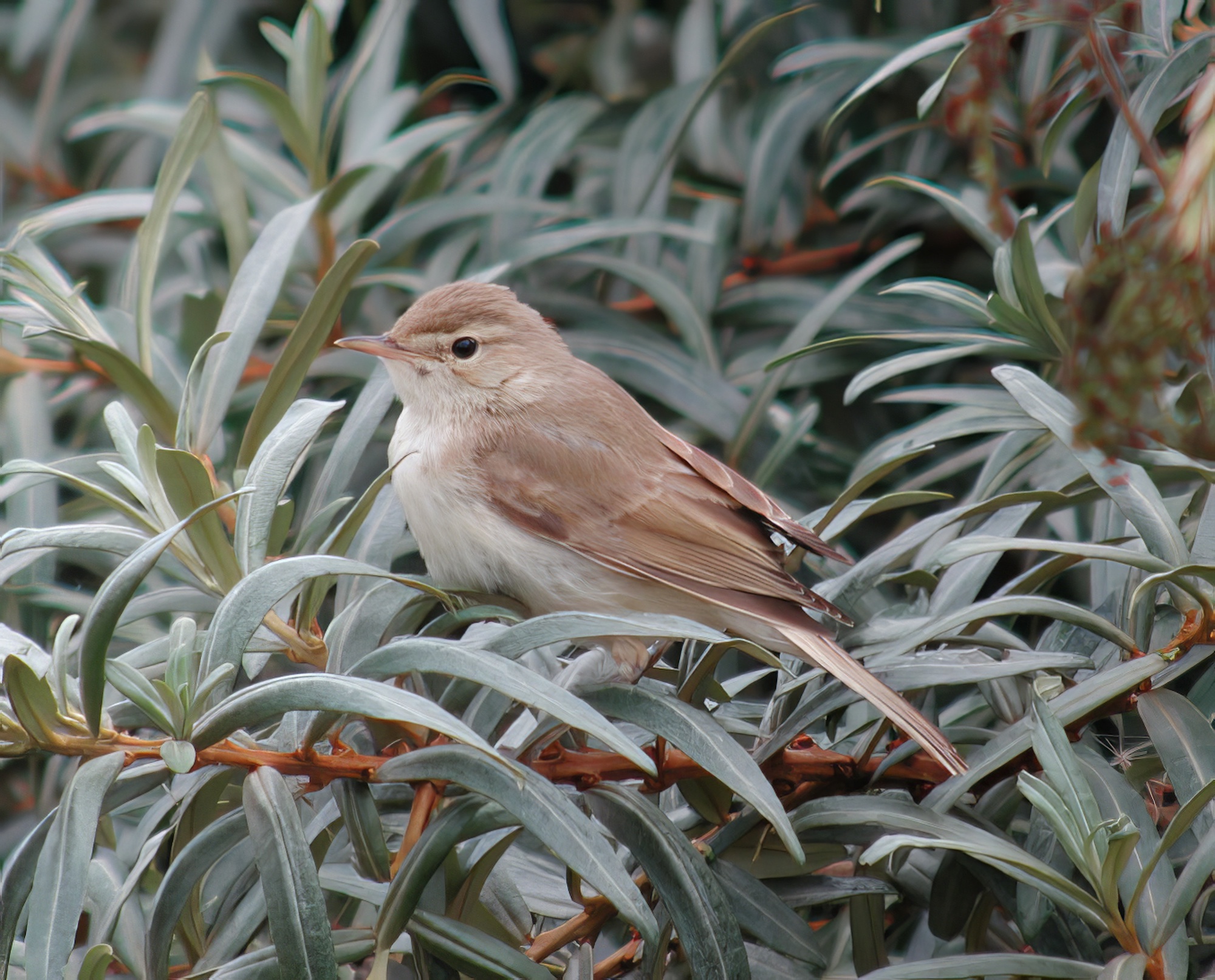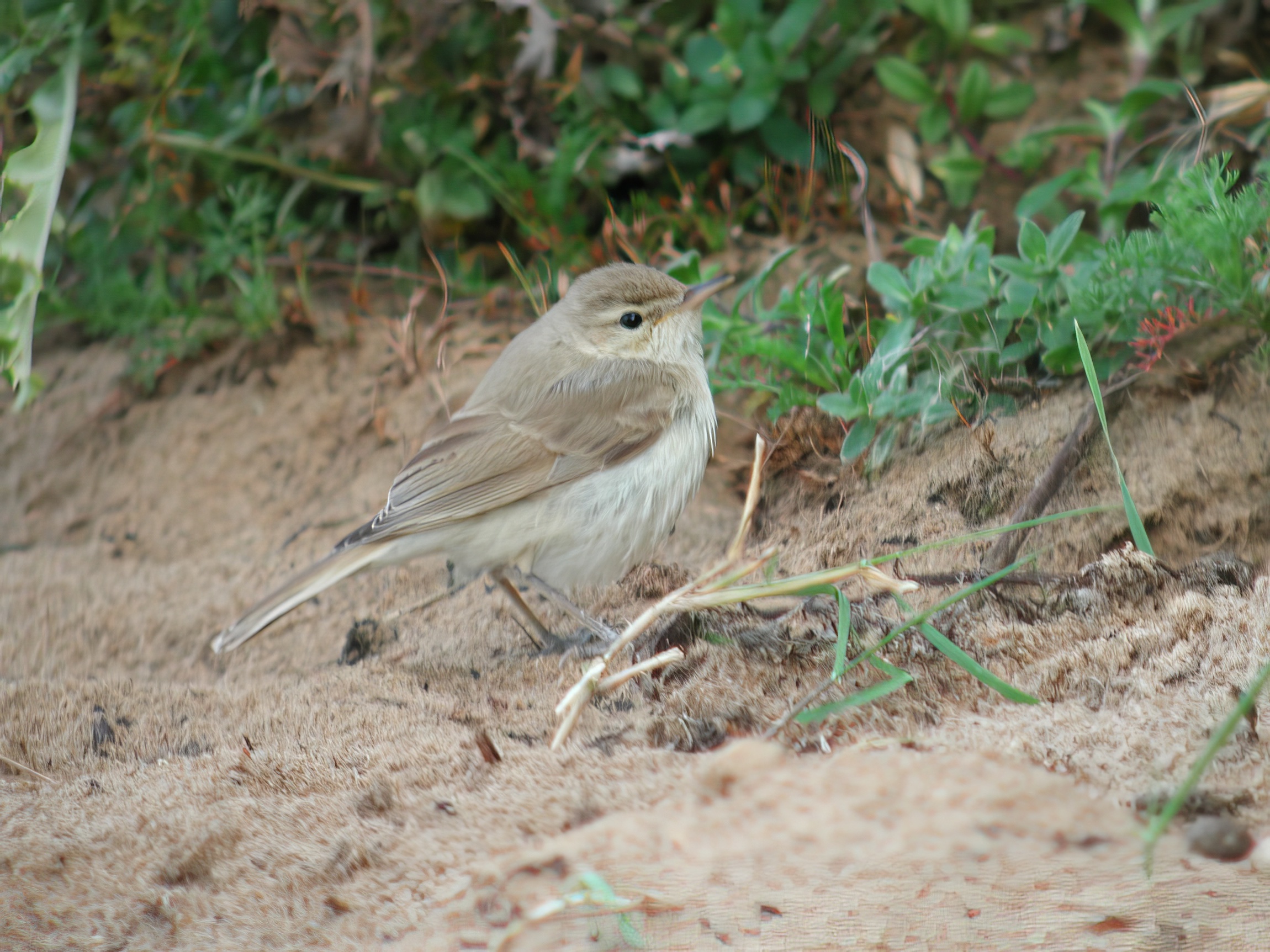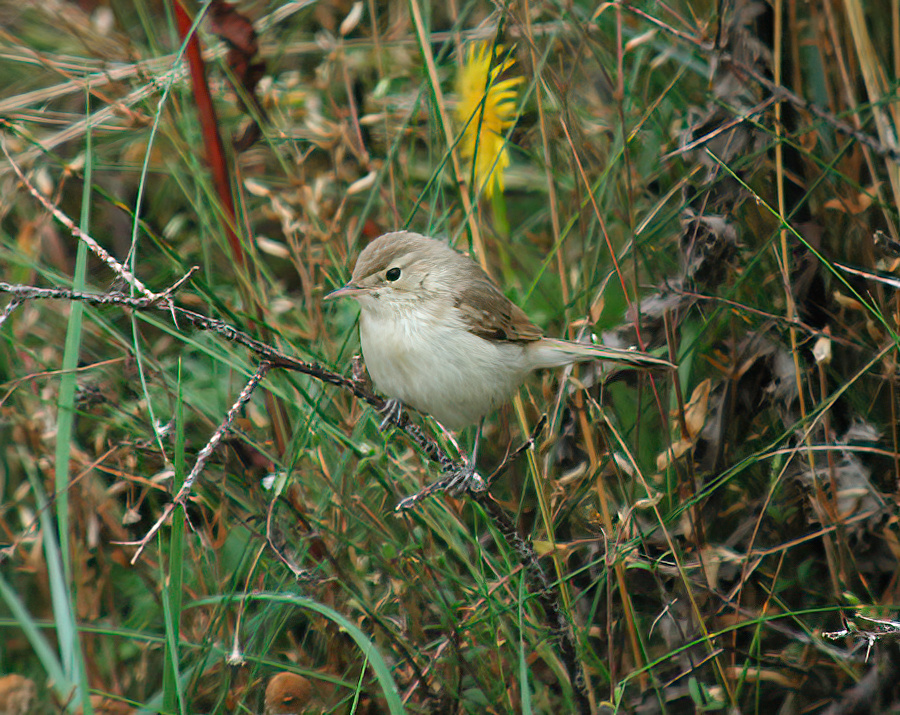Booted Warbler Iduna caligata
Vagrant. Central Asia.



Booted Warbler at Donna Nook on September 6th 2003 (Graham Catley).
There are two county records: one trapped and ringed at Theddlethorpe in October 1980 and the second more than 20 years later at Donna Nook in September 2003. The latter bird frequented thick coastal scrub but eventually worked its way through to the seaward side of the dune where it showed well in a stand of Mayweed, Tripleurospermum sp.
Formerly in the genus Hippolais, Booted Warbler was moved into the genus Iduna in 2009 and is monotypic. The first British record was shot on Fair Isle in 1936, the second only arriving 30 years later. Since then the flood gates have opened and the British total to 2018 is now 169 records, with around 50 records in each of the last three decades with most turning up in mid-September. Booted Warbler breeds from Finland across western and central Russia and Kazakhstan to the north-western reaches of China and Mongolia, with the entire population funnelling down to India and Sri Lanka for the winter. It had long formed part of the genus Hippolais but was re-classified in the genus Iduna in 2009.
Eastern Olivaceous Warbler and Sykes's Warbler are both confusion species. The former is a bigger bird and has a bill that is longer and narrower than Booted with an unmarked tip to the lower mandible. Eastern Olivaceous & Sykes's both lack the dark lateral crown stripe that sometimes appears to form an upper border to the supercillium in Booted.
| Site | First date | Last date | Count | Notes |
| Saltfleetby-Theddlethorpe NNR | 12/10/1980 | - | 1 | 1CY bird, trapped |
| Donna Nook | 06/09/2003 | - | 1 |
Finder's Report: Booted Warbler at Theddlethorpe dunes,12th October 1980: first county record - in the mist net.
by M. Boddy.
Circumstances
The bird was captured at approximately 11.00 a.m. in a mist-net sited in a firebreak through 10 ft. high sea buckthorn at Crook Bank NNR. It was also seen by P. R. Boddy, B. Watkins and K. Watkins. South-easterly and easterly winds had been blowing for two days, from 'lows' over the Continent. A modest fall of Redwings had taken place at dawn on 11th October and soon after dawn on 12th a considerable fall of Goldcrests, Blackcaps and Blackbirds became apparent. One Firecrest and one Garden Warbler were also captured. ·
At a distance of several feet in the net, the general impression was of a small, very pale 'Reed Warbler' type bird. Once the bird was handled, it was obvious that it was not a species known to me; the generally light sandy grey-brown back, with white underparts, and off-white outer half of the outer pair of tail feathers, confirmed that it was out of the ordinary. (In the hand, the side-view of the head only resembled a Phylloscopus warbler, due mainly to the relatively short bill; this fact has been noted before in connection with this species). Reference to Williamson's guides, to Svensson, and to two field guides indicated that it was most likely Booted Warbler, and a detailed description was taken and recorded in my ringing log. The following account is taken from the log.
Description
Plumage
Greyish -brown above, all white below. Mantle grey-brown, rump and upper tail coverts sandy-brown; tail sandy grey-brown, with outer tail-feathers brownish-white and penultimate tail feathers white-tipped. Broad buffish-white supercilium, ending square 4mm behind rear of eye; narrow white ring around eye; lores sandy brown. Throat white, with ill-defined and faint narrow, sandy throat band; belly pure white; undertail coverts buff-white. Primaries grey-brown; all coverts tipped sandy-buff brown; sandy tertials with broad buff tips. Tail with obvious fault-barring; bird generally abraded, particularly the tail feathers. No moult could be found.
Soft parts
Bill dark grey-brown above, pink at base of lower mandible, then grey (3mm) and yellow tip (1 mm). Legs bluey/pinky grey; soles olive-yellow. Mouth bright orange-yellow. Iris deep brown.
Biometrics
Wing: 63mm. Tail: 50mm, almost square, 3rd pair of feathers 2.5 mm longer than 1st (outer) pair . Bill to skull: 13.5mm. Bill to feathering: 9.5mm. Tarsus: 22mm. Weight: 8.5g at 1100 hours.
Wing-formula: Emarginated primaries: 3rd, 4th, 5th, and 6th – just visible. Wing-point: 3rd primary; 4th 0.75 mm shorter; 5th 2mm; 6th, 4mm; 7th, 7mm; 8th, 10mm; 10th, 12mm.
Second primary: 5mm shorter than wing- point, fell between 6th and 7th, 0.5 mm shorter than 6th. First primary: 5mm shorter than primary coverts.
Conclusion: The bird can only have been a first-winter Booted Warbler, Hippolais caligata*. The wing formula conformed to the annectens subspecies data given by Williamson, for 1st winter birds from the Tien Shan range. This is the first county record for this species.
*Taxonomic note: since this account, Booted Warbler has been reassigned to the genus Iduna and is considered monotypic.
Finder's report: Booted Warbler at Donna Nook, September 6th, 2003: second county record - in the field.
by Graham Catley, Craig Nimmick, Neil Drinkall and Keith Parker.
Circumstances
A forecast of south-easterly winds on September 5th, 2003, tempted GPC to try Donna Nook in the hope of a small fall but as the weather on arrival was a strong south/south-westerly with hot sunshine the hoped for fall was indeed small - two Whinchat and three Willow Warblers. The same afternoon Roy Harvey managed to add a Pied Flycatcher and a Garden Warbler to the day's tally so when Neil Drinkall (ND) and Craig Nimmick (CN) suggested another visit on the Saturday, I was eventually convinced that it might be worth it, but was far from hopeful. CN, ND, Keith Parker (KP), and myself arrived at Stonebridge car park, Donna Nook at 07:30 on the 6th having driven through heavy rain but the wind seemed to be north-west! The first four-hour foray to Pye's Hall revealed a Redstart, three Whinchats, a Wheatear and three Willow Warblers – it was not looking good. After a slow lunch we decided on a walk to the RAF trees at Ponderosa in the hope of a Pied Fly. After gaining permission to explore the seemingly bird-free trees we were warned of an afternoon barbeque and function all of which enhanced the feeling of depression.
Having seen no more birds we spread out along the edge of some dead elders and buckthorn backing the sand dunes; after a few minutes CN picked up a warbler that he thought looked interesting and very pale. We were all soon with him but two Whitethroats, a Blackcap and three Dunnocks were about the size of it. Then I picked up a sandy-looking warbler sat in a dead Elder which at first glance reminded me of a Desert Warbler. It was being chased about by the Blackcap and all of the birds in the loose flock seemed unsettled. After some more brief views at about 60 m range with only bins I was beginning to think it must be a Booted Warbler, but views were poor, then the whole flock seemed to move off through the scrub and disappear to the north. In case the
birds were moving off along the dune ridge we quickly moved round onto the edge of the beach and started to scan the scrub. There was little action so I walked further north and into the low sea buckthorn where almost immediately I flushed a warbler from near my feet but as it flew into some low scrub its prominent white outer tail feathers and apparently long tail made me suggest it might have just been a Whitethroat. Very quickly though it worked its way to the front of the scrub and peered out giving me a head on view which brought the exclamation “IT’S A BOOTED!”
As soon as it appeared it then disappeared into the dense buckthorn and the other three had not yet had a decent view of it . Moving onto a concrete gun emplacement I picked it up aga in in some dead ragwort and ND and KP obtained decent views before it again went into the buckthorn. Now convinced it was a Booted (or Sykes’s) we rang all the local Lincs birders but due to the imminent function in the RAF base we were concerned about making it too public in case the bird went back into the RAF bushes. I could not remember the full features of Sykes’s Warbler, but the underparts of our bird looked very white, and the bill and tail appeared long at times. Billy Simpson was by chance passing by on the beach-side, so we called him over and soon got into the Booted - Sykes's debate over several mobile phone calls. In the meantime, the warbler showed intermittently in the low buckthorn where it fed close to the ground but from about 20-25m range.
It now seemed fairly settled so we put the word out with the caveat that Sykes's had not been ruled out at this stage but messages on pagers tended to suggest that it was only a probable Booted for which we have been chastised by many birders!
By 16:30 the bird was not showing any better so the four of us decided to head south to lo ok for a Red-backed Shrike seen earlier in the day by Steve Lorand. While making the unsuccessful search for the shrike Dave Hursthouse arrived from Spurn - having been in touch with Andrew Lassey he confirmed that our bird was indeed a Booted and that Sykes's was ruled out. Checking the literature later we all agreed with the expected ID. A phone call from Andy Sims informed us that the Booted was showing extremely well on the track side by the beach so we sprinted back to find the bird feeding in daisies and dead ragwort along the edge of the main beach-side path where we watched it for another 90 minutes sand where I obtained a series of photos.
Description
In direct comparison with Whitethroat, it appeared of similar size but more truncated. Posture made its general appearance vary over time. When first seen it appeared long tailed and long billed, the latter possibly accentuated by the damp head feathers noted in early observations. Later when feeding on the ground the tail was shorter and square-tipped, the bill tip tilted, and the overall impression became more Phylloscopus-like. At no time did it look like an Acrocephalus sp.
The overall colour of the upperparts appeared to vary considerably with the light and also with reflections from the vegetation in which it was feeding. In bright sun it looked very pale, washed out and sandy - the classic milky tea colouration. In shade though, and when in green vegetation, it often looked much more grey-tinged. The underparts usually looked strikingly white but when observed from very close range and in duller light they appeared creamier with a very faint tinge of buff on the upper breast near the carpal.
The bill was fine and quite pointed, not out of proportion with the head, and the upper mandible dark was with orangey-pink cutting edge. The lower mandible was pale horn to orangey-pink with a small dark smudge on the underside just before the tip. Legs and feet a bluish-grey on the front with paler fleshy rear.
Head was quite well patterned, especially in flat light when contrast was accentuated. The crown was pale milky-brown to sandy-brown fading into a paler nape. A well-marked pale creamy supercilium extended from the bill (where it appeared to bridge the culmen) back to the eye where it kinked upwards and broadened behind the eye fading out at the rear of the ear-covert. Above the supercilia were marked, darker brown coronal stripes which again varied in prominence with the light but were always visible. The lores were pale brown broken by the dark eye but continuing behind the eye as a dark upper border to the ear-coverts. The lower edge of the ear-coverts was pale brown but darker than the creamy centres to the ear-coverts and forming a darker front border. Chin, throat, and underparts white to cream with a faint buff wash near the carpal.
Upperparts all pale sandy, tinged brown. On the closed wing the large alula feather was consistently the darkest feature (see photos). Centres of greater coverts and tertials darker brown than edges which were paler, faint buff. Edges of flight feathers were the same milky-brown as upperparts. Primary projection rather short about a quarter to a third of the tertial length. Rump and uppertail coverts slightly more rusty than rest of upperparts. Tail darker sandy-brown with very obvious whitish cream outer webs to outer tail feathers, very noticeable in flight and clearly visible on the feeding bird.
Wayne & Claire Gillatt and KP heard the bird call, but transcriptions varied from a ‘teck’ to a series of ‘checks’.
This is, surprisingly, only the second record of Booted Warbler for Lincolnshire following one trapped at Theddlethorpe in October 1980. It is a species I have been looking for many years!
References
Boddy, M (Undated). Accounts of Lincolnshire Rarities: Booted Warbler at Theddlethorpe Dunes, 12th October 1980. Lincolnshire Bird Report 1980.
Catley, G.P. (Undated). Finder's Reports: Booted Warbler at Donna Nook September 6th 2003. Lincolnshire Rare & Scarce Bird Report 2003-2007, 150-151.
(Account prepared October 2017; includes all records to 2016)

